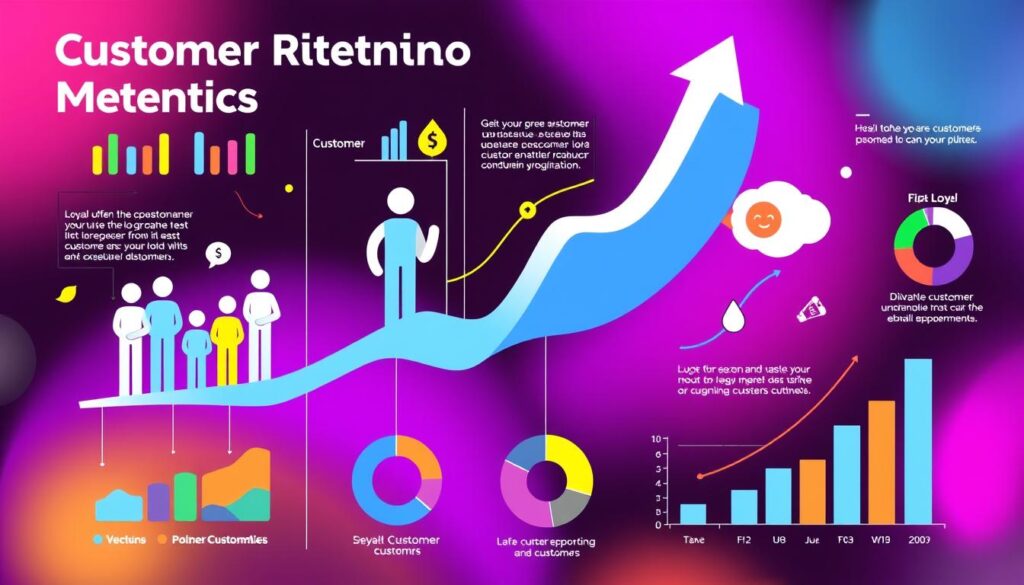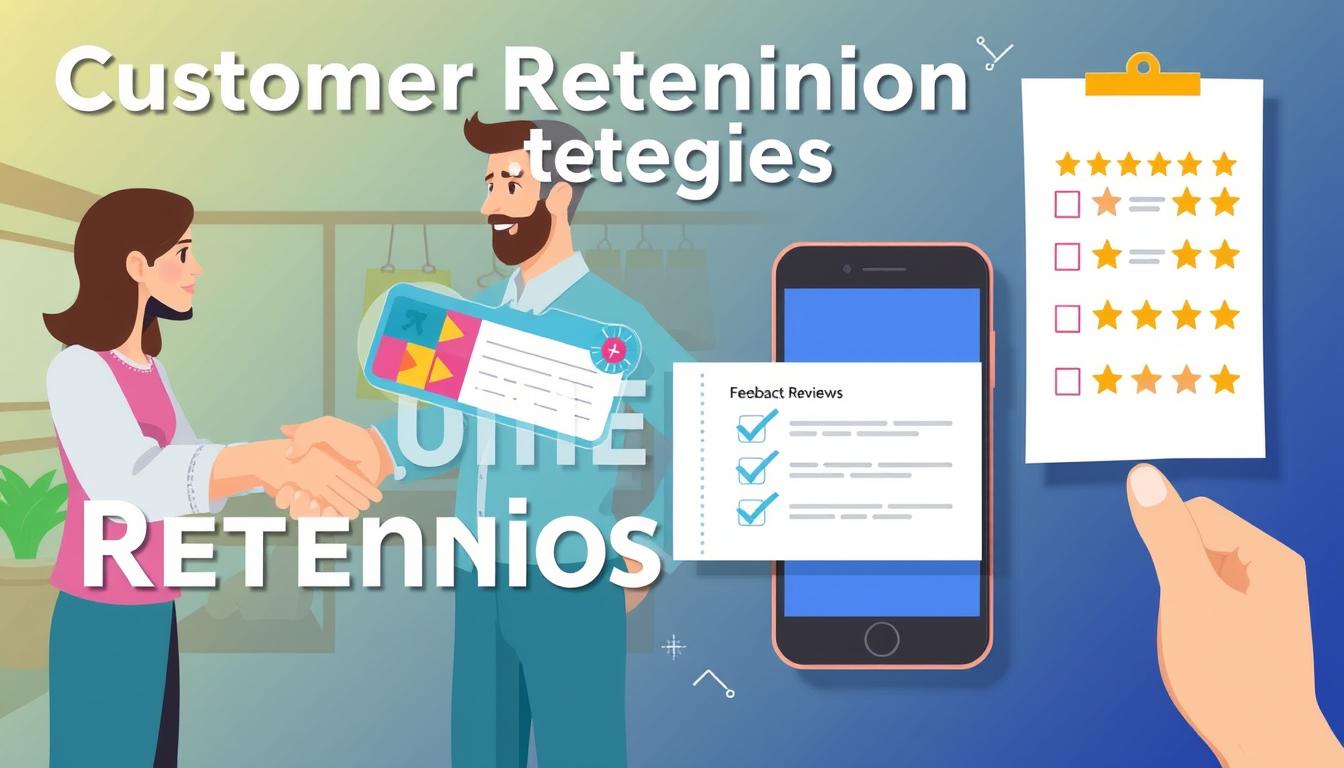Ever wondered why some businesses do well while others don’t? It’s all about keeping customers and engaging with their reviews. We’ll explore strategies that can boost your business’s success over time.
In today’s market, keeping customers is key. It’s cheaper to keep customers than to find new ones1. This shows how vital focusing on loyalty and feedback is.
Trust is key to keeping customers. Most customers trust a brand before buying from it1. By always offering value and interacting with reviews, you can build trust.
Retention rates vary by industry. Media has an 84% rate, while banking is at 75%2. These numbers show the need for specific strategies for different sectors.
Personalization is also crucial. Most marketers agree it helps in building customer relationships1. It’s important to customize your approach to meet each customer’s needs.
Key Takeaways
- Customer retention is more cost-effective than acquisition
- Trust is crucial for customer loyalty
- Retention rates vary across industries
- Personalization significantly impacts customer relationships
- Engaging with reviews builds trust and improves retention
- Consistent value delivery is key to long-term success
Understanding Customer Retention and Its Importance
Customer retention is about keeping customers over time. It shows how loyal and engaged they are. We use a simple formula: CRR = ((E-N)/S) x 100. E is the ending customer count, N is new customers, and S is the start count3.
Retention rates vary by industry. Retail has about 63%, while professional services and media hit 84%4. Most companies want a rate above 85% because it boosts profits3.
Keeping customers is key. It’s 6 to 7 times cheaper to keep them than to get new ones4. Good strategies can increase revenue by 25-95%4. This is why companies focus on keeping customers engaged and loyal.
| Industry | Average Customer Retention Rate |
|---|---|
| Retail | 63% |
| Banking | 75% |
| Telecom | 78% |
| IT | 81% |
| Insurance | 83% |
| Professional Services | 84% |
| Media | 84% |
To keep customers, companies use many strategies. They improve onboarding, create clear roadmaps, and use feedback for better products. Personalized social media support, segmenting customers, and loyalty programs also work well3. These efforts help lower the churn rate and make customers happier.
The Role of Reviews in Customer Retention
Reviews are a big deal for keeping customers around. They show others what to expect and help make buying choices. When reviews are good, they make customers feel more confident and loyal. But, if they’re bad, they give a chance to get better.
What customers say is super important. It shapes how people see a brand and how happy they are. More than 94% of people buy things when they see 4- or 5-star ratings5. This shows how much trust there is in what others say. About 65% like to buy from brands they already trust5.

Reviews online are really strong. They can almost double a company’s value from customers in just a year5. This is because they turn new customers into regulars. Princess Polly saw its average order go up by 112% by showing off what customers made and rewarding them for sharing their thoughts6.
Social proof is really important. It helps more people buy and keeps them coming back. Almost 87% of shoppers do something after seeing what others like on social media6. This shows how reviews and rewards can work together to keep customers coming back and trust your brand more.
“Reviews are the backbone of customer retention. They build trust, drive sales, and create a community around your brand.”
We can’t overlook how big of a deal reviews are for keeping customers around. They’re not just feedback. They’re a key tool for growing, keeping customers loyal, and succeeding over time. By using reviews well, brands can make a cycle of good experiences and strong customer relationships.
Strategies for Engaging Customers Through Reviews
To keep customers coming back, we must use smart review engagement tactics. A great onboarding experience is key for positive interactions. Personalized experiences are powerful, with 80% of customers valuing them as much as products and services7.
It’s vital to have a customer feedback loop. This means asking for feedback often and making it simple for customers to share their thoughts. Fast delivery and caring customer service can really help keep customers8.
Using a customer communication calendar lets us reach out proactively. This opens doors for upselling and cross-selling. As a result, returning customers often spend 67% more than those who don’t come back8.
“Engage with your customers. Listen actively. Respond promptly. Build lasting relationships.”
Offering unique services that solve big problems can lead to positive reviews and loyalty. Just a 5% increase in customer retention can boost profits by 25% to 95%9. Here are some effective strategies:
| Strategy | Impact | Implementation |
|---|---|---|
| Personalized Experiences | Increased loyalty | AI-driven recommendations |
| Feedback Loop | Improved products/services | Regular surveys, review requests |
| Proactive Communication | Higher engagement | Communication calendar |
| Unique Services | Positive reviews, loyalty | Solve critical pain points |
By using these strategies, we can build a strong review management system. This will boost customer engagement and help our business grow over time.
Leveraging Positive Reviews to Boost Retention
Positive feedback is key to keeping customers around. A huge 79% of people trust reviews as much as advice from friends or family10. This trust helps build strong customer relationships.

Brand advocates are great for spreading the word. They’re 70% more likely to be seen as trustworthy by others10. We can use this by offering rewards for customers who share their good experiences.
Showing off reviews can really help bring in more customers. In fact, businesses that share feedback might see a 270% increase in sales11. This openness draws in new customers and keeps the ones we already have happy.
To make the most of positive reviews, we should:
- Share great testimonials on social media
- Put positive feedback in our marketing stuff
- Build a community around our product or service
- Answer all reviews, good or bad, quickly
By really interacting with reviews, businesses can see a 49% increase in how much customers spend11. This shows we care about making customers happy and turns negative feedback into chances to get better.
“Our customers’ voices are our most powerful marketing tool. Their stories inspire trust and drive growth.”
Keeping customers is way cheaper than getting new ones. Just a 5% increase in keeping customers can lead to a 25-95% profit boost12. By using positive reviews and strong retention plans, we can build a loyal customer base that helps us grow.
Addressing Negative Reviews to Improve Customer Retention
Negative reviews can really hurt a business. With 98% of consumers reading online reviews before choosing a local business, it’s key to handle customer complaints well13. We must take steps to make unhappy customers happy again.
When we get negative feedback, we start by apologizing sincerely. This shows we care about our customers and want to fix problems. Then, we quickly solve the issue. Remember, 62% of people might give a company another chance if we fix the complaint13.

Having a strong system to handle negative feedback is crucial. We use many ways to talk to customers and fix their concerns fast. This shows we really care about making them happy. It’s important to know that 63% of customers might change their reviews if we fix the problem13.
To avoid misunderstandings, we teach our customers about what we offer. This helps lower the number of negative reviews from unclear expectations. By making negative experiences positive, we show we’re all about great customer service.
| Customer Feedback Action | Impact on Retention |
|---|---|
| Prompt response to negative reviews | Increases customer trust |
| Resolving issues efficiently | 62% might give second chance13 |
| Proactive customer education | Reduces misunderstandings |
| Multi-channel support | Improves accessibility |
By handling negative reviews well, we boost customer loyalty and our brand’s image. This approach turns unhappy customers into fans, creating a cycle of loyalty and growth for our business.
Customer Retention: Measuring Success and Setting Goals
Tracking customer retention metrics is key to business success. We focus on important performance indicators to see how well our efforts work. The Customer Retention Rate shows how many customers stay loyal over time. The Customer Churn Rate shows how many we’ve lost14.
Financial impacts are measured through Revenue Churn, which calculates income loss from lost customers. We also track the Existing Customer Growth Rate to see how satisfied customers are14. These metrics help shape our retention strategies.

The Net Promoter Score (NPS) measures customer loyalty by how likely they are to recommend us. We look at the Time Between Purchases to understand buying habits and adjust our strategies14. Forbes says it’s cheaper to keep customers than to get new ones15.
Customer Lifetime Value (CLV) is key, showing the total revenue we can expect from each customer. It guides our long-term plans and helps us focus on keeping customers14. Amazingly, just a 5% increase in keeping customers can boost profits by 25% to 95%15.
| Metric | Description | Impact |
|---|---|---|
| Customer Retention Rate | Percentage of customers retained over time | Indicates loyalty trends |
| Net Promoter Score (NPS) | Measures likelihood of customer recommendations | Reflects overall satisfaction |
| Customer Lifetime Value (CLV) | Total expected revenue from a customer | Guides long-term strategies |
| Customer Satisfaction Index (CSAT) | Measures satisfaction with products and support | Identifies areas for improvement |
By regularly checking these customer retention metrics, we can spot trends, set realistic goals, and improve our strategies. This helps increase customer loyalty and business growth.
Conclusion
We’ve looked into how keeping customers and engaging with reviews can lead to lasting success. It’s clear that retaining customers is both cost-effective and vital for growth. In fact, over 70% of businesses find it cheaper to keep customers than to find new ones16.
Retention is a strong strategy. Just a 5% increase in keeping customers can boost profits by 75%. Engaged customers buy more, spend more, and are five times more likely to stay with a brand16. We use tools like Customer Lifetime Value (CLV) and churn analysis to measure success. These tools help us predict profits and track customer loss17.
Engaging with reviews is crucial for keeping customers loyal. A huge 97% of consumers are more likely to stay loyal if a company listens to their feedback. This highlights the need for continuous improvement in handling reviews16. Remember, 80% of future revenue is expected to come from just 20% of current customers. By focusing on retention and reviews, we’re not just keeping customers. We’re building a stronger, more profitable future for our business16.
FAQ
What is customer retention, and why is it important?
How can reviews help improve customer retention?
What are some effective strategies for engaging customers through reviews?
How can businesses leverage positive reviews to boost customer retention?
How should businesses address negative reviews to improve customer retention?
How can businesses measure the success of their customer retention efforts?
Source Links
- 22 Examples of Customer Retention Strategies That Actually Work – https://blog.hubspot.com/service/customer-retention-strategies
- Customer retention basics, 8 strategies, and metrics – Zendesk – https://www.zendesk.com/blog/customer-retention/
- What is customer retention? – https://www.salesforce.com/eu/learning-centre/customer-service/customer-retention/
- Here’s Why Customer Retention is So Important for ROI, Customer Loyalty, and Growth – https://blog.hubspot.com/service/customer-retention
- Loyalty and reviews are key to customer retention |Infognana – https://www.infognana.com/are-loyalty-reviews-the-driving-force-behind-customer-retention/
- From Reviews to Retention: Building Loyalty with Reviews | Yotpo – https://www.yotpo.com/blog/from-reviews-to-retention-how-brands-can-build-loyalty-with-reviews/
- Customer Engagement In 2024: The Ultimate Guide – https://www.forbes.com/advisor/business/customer-engagement/
- 14 Customer Retention Strategies That Work In 2024 – https://www.forbes.com/advisor/business/customer-retention-strategies/
- Leading Customer Retention Strategies for 2024: Top 10 Tactics with Actionable Examples – Sogolytics Blog – https://www.sogolytics.com/blog/customer-retention-strategies/
- How to leverage Online Customer Reviews – https://www.nicereply.com/blog/how-to-leverage-online-customer-reviews-for-effective-business-branding/
- Maximising the Impact of Positive Customer Reviews on Sales and Trust – https://www.linkedin.com/pulse/maximising-impact-positive-customer-reviews-sales-trust-andy-coghlan-krkye
- How Feedback Management Boosts Customer Retention and Satisfaction – https://rapidr.io/blog/improve-retention-and-satisfaction-with-feedback/
- A Business Owner’s Guide to Responding to Negative Customer Reviews – Inside Advisor Pro – https://www.insideadvisorpro.com/responding-to-negative-customer-reviews-guide/
- 10 Customer Retention Metrics & How to Measure Them – https://blog.hubspot.com/service/customer-retention-metrics
- Retention KPIs: 10 Metrics To Measure Customer Retention – https://userpilot.com/blog/retention-kpis/
- Customer Retention: Get Customers to Come Back to Your Store – https://www.growcode.com/blog/customer-retention/
- Customer Retention | Customerly – https://www.customerly.io/glossary/customer-retention/

